|
February 18, 2006
Selecting the Right Travel Gear: Backpacks,
Clothing and Footwear - Critical to the success of your trip.....
You can imagine, as a travel writer who does a lot of walking,
skating, skiing, mountain-biking, camping etc., the right equipment
in terms of luggage, clothing and footwear becomes an important
element in my toolkit. I am one of those people who’s constantly
frozen for 6 months of the year, so staying warm in this northern
country of ours is another challenge. Not surprisingly long johns
are an essential part of my wardrobe.
So to get a better overview of some of the equipment out there
I went to a workshop this past Thursday on how to buy the proper
travel gear. The presentation was held at the G.A.P
Store in Toronto’s bustling Annex neighbourhood, and although
we were hit by a bout of freezing rain, the subway whisked me in
from Toronto’s East End in just 20 minutes and dropped me
off conveniently almost right in front of G.A.P’s retail location.
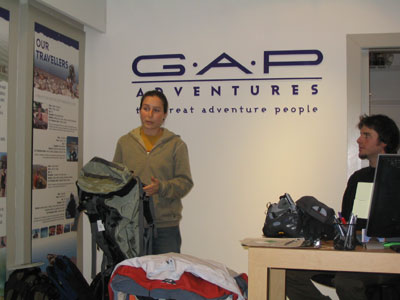
G.A.P Adventures
is Canada's largest adventure travel company and offers small
group adventures in hundreds of locations all over the world. The
G.A.P Store provides computer terminals where you can research various
trips and destinations with the help of on-site travel experts.
Video displays show clips from the record-breaking "Great Adventure
People" TV series, and allow you to explore the world of adventure
travel in a friendly, casual environment. In addition, G.A.P presents
a variety of useful seminars at the store to provide practical information
to travellers.
Karina Benavides and Geoff Atkinson, the presenters of this seminar,
are two young retail experts from the Mountain
Equipment Coop, and were here to educate us about the different
types of equipment available. Today, MEC is Canada’s largest
supplier of quality outdoor equipment. With more than two million
members in 192 countries, MEC is a vibrant retail co-operative.
MEC has stores across Canada, as well as a comprehensive web store
and phone/mail order service. They are a favourite destination for
Toronto’s outdoor enthusiasts and provide expert personalized
advice for whatever outdoor adventure you might be planning.
Karina started us off talking about the different types
of packs available. The first type of equipment for carrying
gear she demonstrated was “expedition-style packs”.
These types of packs are used for extended journeys, mountaineering
expeditions, or winter weekend trips with extra gear and their capacity
is between 40 to 100 litres.
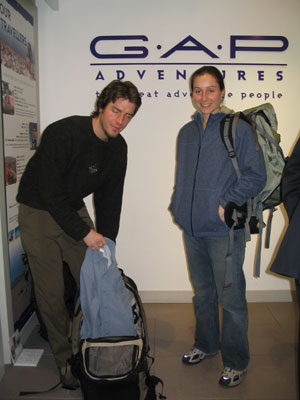
One of the most important features of expedition-style
packs, Karina explained, is their suspension system and
the importance of fit. These types of packs are ergonomically designed
to distribute the weight properly. In order to achieve this purpose,
they have a built in suspension system and a hip belt which helps
keep the weight off the rear end. The belt is supposed to sit right
on the pelvic bone for best support and shoulder straps should not
be too tight. The weight distribution should be 60% to 40% between
shoulders and hips.
The key thing with this type of equipment is to make sure that
it fits properly, depending on the wearer’s spinal shape.
The design is usually cylindrical, with optional entrance points
which Karina referred to as “escape hatches” where you
can pull out an item without having to open up the whole backpack.
Then Karina moved on to the next type of equipment: travel
packs. They hold roughly the same amount of volume as expedition
packs, but are designed more for road tripping and typically these
bags are not as durable because of their load-bearing zippers. Travel
packs have less straps than expedition-style packs and look more
like conventional luggage. They even have side handles and removable
shoulder straps and an extra fabric panel that protects the straps
during airport baggage handling.
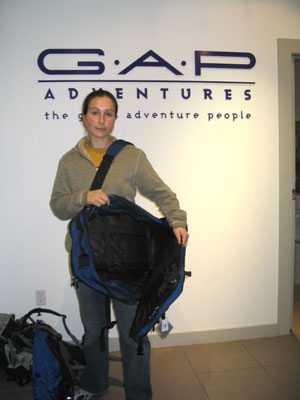
The design is far less ergonomic since this type of gear is intended
more for traveling in airports and train stations rather than backcountry
expeditions. This type of equipment is also not as structurally
strong as expedition gear, but it is designed with more protection
for rough baggage handling during transport. The fitting process
is the same in that MEC’s retail experts will customize the
fit for the purchaser, depending on their individual requirements.
I really was taken in by the next type of equipment that Karina
demonstrated: a travel pack on wheels. It is essentially
a big backpack with built-in wheels and an extendable handle that
also has a detachable day pack. This particular piece of luggage
is designed in such a way that it will comply with airline carry-on
size requirements so you don’t even have to check it in. Karina
mentioned that it is not particurly comfortable to carry, but it
is the perfect compact luggage on wheels and will even handle cobble-stone
roads. She mentioned a story that she went on a trip with a few
friends of hers, and her friends picked up their large duffle-bags
at the airport’s baggage caroussel, slung them over their
shoulders and literally had to shlepp them through the airport,
while Karina was able to just wheel her luggage around without any
strain on her back.
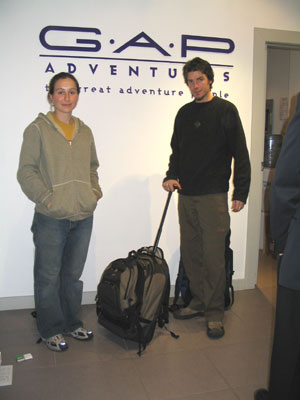
As the workshop went on the equipment got smaller. The next item
Karina demonstrated was a daypack, which is a fairly
simple backpack without any sophisticated suspension system. The
padding on daypacks will depend on the model and manufacturer of
the equipment. The daypack Karina showed us was so small and light
that it could be rolled up and stashed into a larger piece of luggage,
just in case you needed a light piece of luggage for your on-location
activities.
Next we got introduced to a variety of accessories.
Karina first showed us rain covers for back packs.
These items are put over expedition-style packs and keep them dry.
They should not be put on the packs during air transportation since
they easily get ripped off. The beauty of rain covers is that it
prevents the aweful smell of backpacks when they get wet and everything
inside stays nice and dry.
Karina also showed us a small money belt that
can fit around the waist. It is very flat with a zipper and I bought
the same model last year for my
trip to Cuba to hide my passport, credit cards and small change.
This item works like a charm since it can be hidden under your t-shirt
so nobody knows where you are keeping your valuables. Karina also
mentioned neck wallets, which are much more popular with men who
wear them underneath their shirts. Another type of concealable wallet
are leg wallets that can really only be worn comfortably underneath
long skirts.
The next accessory on tap was a voltage converter,
an important item to make sure that small electric appliances will
work in different countries around the world.
Then Geoff took over and talked about his specialty: clothing.
He mentioned right off the bat that layering is key. He started
off with the base layer that essentially has two
main functions: moisture management and insulation. The lightest
type of base layer is called “silk weight” and is mostly
used by people involved in heavy exercise: runners, cross-country
skiers and hikers. Cotton is rarely used as a base layer since it
does not wick moisture away from the body very well and it also
dries very slowly.
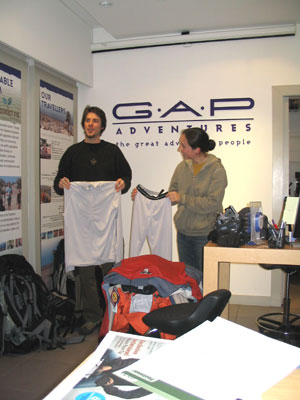
Merino wool is another popular material for base
layers. It is a very fine wool and spun into a delicate knit, definitely
not scratchy at all. Merino wool absorbs moisture into the spongy
core of its fibres. Synthetic fabrics like Polyester dry very quickly
and wick moisture away from the body. The main difference between
Merino wool and synthetic fibres is price (Merino wool is about
twice the price), and odour retention. Synthetic fibres
retain odour a lot more, which may be an issue when you
are on a multi-day trek without access to laundry facilities. Wool
also insulates better over a broader range of temperatures.
Base layers come in different thicknesses, from light weight, to
mid weight to, you guessed it, heavy weight or expedition weight.
The difference is the amount of insulation that the base layer provides.
I asked Karina after the workshop what her advice was for me, since
I am always freezing and I’ll be heading off shortly to go
skiing to Banff/Lake Louise. She suggested wearing a thick base
layer plus one or even two extra layers of fleece pants under my
ski pants in the event it gets really cold.
Then Geoff touched on trekking clothing and demonstrated
a variety of shirts and pants designed to be worn on their own in
warmer climates. One of the trekking shirts, made of synthetic material,
had vents underneath the armpits and in the chest area to help with
perspiration management. Mesh inside the garments adds an extra
layer of air. Geoff also demonstrated convertible pants or Explorer
pants where you can remove the legs with a zipper and be
left with shorts. These types of pants are handy in tropical climates
where you can decrease your leg coverage by simply removing the
lower part of the pants. And it saves on packing space too since
one garment will function as a full-leg pant and as a pair of shorts.
Many of the pants have cargo pockets and built-in belts. Some of
them are made of stretch material which makes them even more comfortable
to wear.
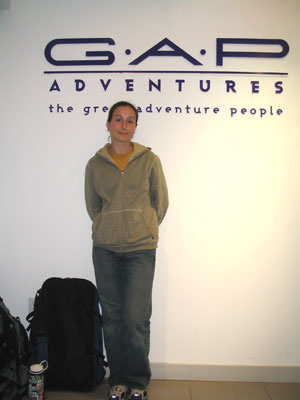
Then Geoff moved on to mid-layers whose purpose
is to provide additional insulation and to disperse perspiration
away from the base layer. Geoff demonstrated a vest
that was made of a very slick material and could glide easily over
other layers. In addition, it could roll up into a tiny ball to
take up very little space inside the luggage and still provide major
insulation from the cold. This type of vest can even be used as
an outer layer on dry, not overly cold days.
Our next item on the agenda were outer layers.
Geoff demonstrated various outer garments, including a raincoat
made of a waterproof/breathable material with a nylon outer fabric.
This garment is handy for high winds and/or rain while moving in
moderate to cold weather because body moisture can escape through
the material without comprimising waterproofness. (There must be
a temperature and humidity difference from inside to outside the
garment for it to "breathe" effectively). This nifty item
could fold up and be stashed away in a little pocket that was sewn
right into the raincoat. We also saw a fleece jacket and a wool
jacket that had a rather elegant look to it.
Fleece can be made wind/water resistant, but is
usually not. Traditionally, fleece is very breatheable and is a
great insulator, even when damp, very much like wool. Some of the
fleece garments are wind resistant and offer a slight level of water
resistance. Geoff then demonstrated an affordable and light-weight
Hydrofoil jacket. It offers some breathability because of its semi-porous
fabric. The pores are not big enough to let water in, but they do
let some of the body’s moisture escape. It had pit vents and
some of the models have detachable hoods.
The next item to be covered were waterproof outer shell
pants which are usually taken on or off during mutli-day
hikes as the weather changes. Many of these types of pants have
zippers at the bottoms or even all along the side of the leg to
make it easier to get into the pants without having to take any
boots off. This comes in particularly handy when you are hiking
in the back country and your boots are muddy.
We then covered a few accessories, such as sun visors who also
have a windstopper function built in. We looked at really cool light-weight
gloves and a mid-weight type of toque that is very popular among
runners, cross-country skiers and even cyclists who wear it under
their helmet.
We also briefly touched on footwear, and found
out that there are lots of different choices out there. The key
rule with footwear is: go as light as you can since every additional
pound of weight on your feet makes your journey so much tougher.
Every pound on one’s feet generally takes as much effort as
five pound in one’s pack, so it’s worthwhile to select
the appropriate footwear.
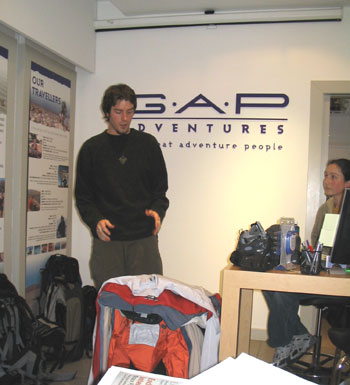
Sandals are very popular and they even come in
technical versions with sticky rubber outsoles. They come in land-oriented
and amphibious versions. Trail running shoes provide
impact protection and motion control while outdoor athletic
shoes are hybrids. They usually have durable rubber soles,
similar to hiking boots, but are light-weight with less ankle support
than full-on boots.
Dayhikers usually have a mid-cut, similar to conventional
backpacking boots, but are made from lighter fabrics and suede material.
Backpacking boots are stronger, heavier versions
of dayhikers and provide more ankle support and impact protection.
After the official presentation by our experts from the MEC
was finished I also had a chance to ask about some of my own personal
clothing issues and other seminar participants also got their equipment
questions answered. I also had a chat with Jerry Da Costa, the manager
of the G.A.P
Store, who provided me with some information about some of G.A.P's
Latin American trips since I am considering to travel somewhere
to Argentina and/or Chile in one of my next trips. These are two
places I have always wanted to visit.
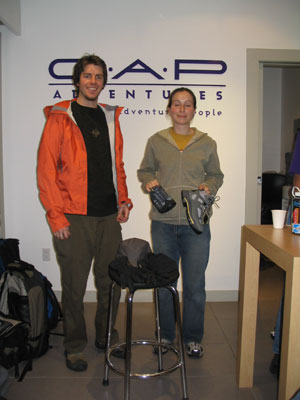
Small group travel is an excellent concept, especially for a woman
travelling by herself to foreign destinations that involve an element
of personal risk and culture shock. You always have the safety of
the group and expertise of the group leader to fall back on.
I am thinking of combining a language study trip to Buenos Aires
with a small group adventure trip to Argentina and/or Chile to get
the best of both worlds: to combine the wide expanses and varied
destinations of Latin America with an exploration of one of the
most fascinating urban centres in the world.
Now that I know all about the eqiupment, let the planning begin......
Related Articles:
More advice from the G.A.P Store: The
Wonders of Brazil
G.A.P Adventures
is Canada's largest adventure travel company and a leader in socially
and environmentally sensitive travel. G.A.P is also the sponsor
of the grand prize for our first story contest: an exciting adventure
cruise on the Amazon on the historic and unique Explorer expedition
cruise ship. Visit our contest page to find out more about our
first travel story contest.
|